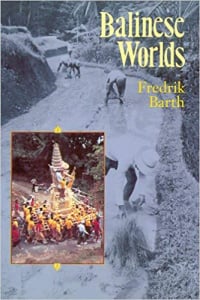Balinese Worlds
- Title
- Balinese Worlds
- Original language
- Author(s)
- Illustrator(s)
- Publisher
- University of Chicago Press
- ISBN
- 978-0226038346
- Publication date
- 1993
- Subjects
- ethnography
- culture
- agriculture
- anthropology
- religion
- Find Book
- Amazon
- Related Env. Initiatives
- Related Places
- Related Biographies
- Related Children's Books
- Related Holidays
- Related Folktales
- Related Comics
- Related Lontar
- Linked words
Description(s)
In Balinese Worlds, Fredrik Barth proposes a new model for anthropological analysis of complex civilizations that is based on a fresh, synthetic account of culture and society in North Bali and one that takes full notice of individual creativity in shaping the contours of this dynamic culture. In this detailed ethnography of the Northern district of Buleleng, Barth rejects mainstream anthropological generalizations of Bali as a cultural system of carefully articulated parts. Instead—drawing on many sources, including the sociology of knowledge, interactional analysis, postmodern thought, and his own exceptionally varied field experience—Barth presents a new model that actually generates variation. Barth's innovative analysis of Balinese life highlights both the constructive and the disorganizing effects of individual action, the constant flux of interpretation, and the powerful interaction of memory and social relationships, and knowledge as a cultural resource. Balinese Worlds is a unique contribution not only to Balinese studies but also to the theory and methods of the anthropology of complex societies. The villages of Pagatepan and Prabakula are used as a basis for these studies.







Enable comment auto-refresher